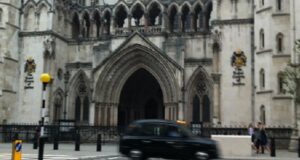Peabody Housing Association was established in 1862 by the US banker and philanthropist, George Peabody. Nowadays their mission is “to ensure that as many people as possible have a good home”. Really?
In Tower Hamlets, Peabody has been known as the “vandal landlord” after it knocked down the last surviving Jewish Maternity Hospital in Underwood Road in order to build a dreary, standard block of flats – most of which were for private sale – which took up a good tranche of the pavement. Now Peabody has offered us a glimpse of just what its mission means – and how it puts more emphasis on the “good” than on the “many”.
Peabody has announced that the interiors of the properties in four of its new developments (two in west London, two in east London) have been inspired by their respective locations – by the “cultural, artistic and economic split between East and West London”. By the what? Surely it is not decorating its flats to remind us that the rich traditionally live in the west end of most western cities, with the poor being cooped up in the east (though that arrangement has been somewhat kebab’d in London by the imaginative promotion of east London as the new home for the rich)?
Yes, it turns out that is pretty much their thinking. According to Peabody, when Londoners are deciding where to live, we now weigh up the “age old questions, East vs. West, trendy vs. traditional, edgy vs. classic.” They go on: “you can still distinguish between the East and West’s defining characteristics with the East’s style coloured by the area’s industry, a mix of cultures and the docklands area and the West with its early influences from the aristocracy, royalty and easy access to green open space.”
There are now approximately 2,000 Tower Hamlets residents who are living in short term accommodation because they are homeless. How many of them are sat in their hostels, their B&Bs, their temporary accommodation weighing up whether they want to living in a trendy and edgy area or a traditional one? Ironically, in past decades they may have looked to Peabody to help house them. Nowadays, Peabody’s priorities seem to be elsewhere.
How will all this inspiration be applied? “Clare Morton of Studio Morton and Gabriella Ramacotti of Suna Interior Designs were both tasked with creating modern and sophisticated show homes for Chancery Building, Carters Yard, Merchants Walk and Upton Village whilst drawing on local influences.” Gone are the days when the in-house builders would nip down to Woolworths for a few tubs of white emulsion, then.
Let’s concentrate on the east London sites. That’s EAST London – it’s worth stressing the point, as otherwise you may not recognise it. Here is what Peabody has to say: “the East’s quirky and eclectic flare inspired both Upton Village’s Shared Ownership show home in Plaistow and Merchants Walk’s Private Sale show home in Bow. A turning point in the history of art and design in the East London came with the opening of White Cube Gallery in Hoxton over 20 years ago.”
Quirky and eclectic? Did you notice that? No, nor did we. We thought the turning point in how our area looked came when vast swathes of publicly owned land were handed over to developers to make profits out of. However, at least the key point is now out: the Peabody developments are for sale, not social housing!
Let’s have a quick read of how the homes for sale in Tower Hamlets were designed. “Further reflecting the East-end feel, Merchants Walk is located between Canary Wharf and the Olympic Village in thriving Bow, E3. Clare [Morton of Studio Morton] recently completed the private sale show home for this scheme and explains, ‘The design is very East London and it’s almost a reflection of Upton Village. We took inspiration from the branding, creamy colours with blacks, whites and greys. This private sale show home features more standout, quirky and daring pieces of designer furniture to reflect the industrial trend in this part of London. This has been created through token industrial pieces made out of metals as well as using wallpaper that looks like textured concrete. A big trend in East London is stripping back the inside of buildings to bring in exposed brick and concrete floors, which is something that is featured in the show home.’”
Well, if you feel you can warm to all this pretentiousness, do contact the Merchants Walk sales team. It’s only 70% sold, so perhaps you can find something to suit. Prices range from £342,000 to £585,000.
What has become of Peabody and its mission to house those in need? And they wonder why there is a housing crisis…
[Adverts]
 East London News A Force for the community…
East London News A Force for the community…




